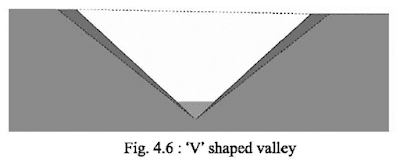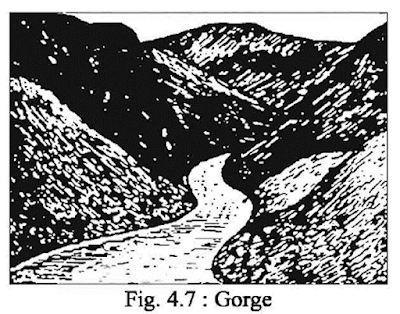Definition of river : In the high mountain, plateau or highland where rainfall, spring, glacier or melted waters from the glacier flow downwards due to gravitational force in a fixed course is called a River. The river flows in a course through plains and reaches at ocean or lake. The origin of the river is called the Source of river. The place where the river reaches the ocean or lake called the Mouth of the river. The extended area along the Mouth of the river is called the Estuary.
River course : River is important in the life of the people. All ancient civilizations flourished beside the river. At that time river was the only medium through which people could move around.
Doab : Land between two active rivers is known as doab.
Confluence: When two or more rivers meet together at a place is known as confluence.
Tributary : A stream or river that flows into a main stream or a lake is called a Tributary. A tributary does not flow directly into a sea or ocean.
Distributary : A stream that branches off and flows away from a main stream channel. They are common in the delta areas in the lower course of the river.
River valley : A valley formed by flowing river is called by River valley.
River bed : The river bottom through which river flows is called the River bed.
River basin : The vast regions having branches of rivers through which water flows from its origin and fall into ocean and lake are called River basin.
On the basis of area, depth, slope, velocity from the source to the mouth of the river, the life cycle of a river has been divided into three stages (fig. 4.5). These are :
1. Youthful stage/upper course
2. Mature stage/middle course
3. Old stage/lower course
1. Youthful stage/upper course: Youthful stage/upper course
is the primary stage of the river course. The upper course of the river is from
the origin in the mountain up to reaching the plains. In the upper course or
youthful stage the main work of the river is vertical erosion. In the upper
course the river erodes the landforms and transports it.
2. Mature stage/middle course : When the river
enters the plains it is called the work
starts. In Mature stage. In the mature stage the velocity of the river reduces
and the deposition this stage lateral erosion is more than vertical erosion. In
mature stage alluvium is deposited on the banks of the river which eventually
forms the alluvial plains. Majority of lands in Bangladesh is alluvial plains.
3. Old stage/lower course : Lower course is the
last stage of a river where it reaches the ocean. At this stage velocity of the
river decreases. There is no vertical erosion and very less lateral erosion.
River is very wide and shallow. Due to decrease of velocity of river flow,
alluvium is deposited at the river mouth forming deltas.
Landforms from River Erosion
'V' shaped valley : In the upper course of the
river due to high velocity large rocks are broken down and transported
downwards. Mountains are formed with hard and soft rocks. In the
river course soft rocks are eroded more and cutting downwards makes the channel
shape like a 'V'.
The sides of the mountains are less eroded as the lateral
erosion at this stage is less (fig. 4.6).
Gorge and Canyon : A
gorge is a narrow valley with steep rocky walls located between hills or mountains.
Rivers carve through hard layers of rock, breaking down or eroding. Sediment
from the worn away rock is then carried downstream. Over time, this erosion
will form the steep walls of gorge (fig. 4.7). The Indus river gorge is 518 metres
deep, one of the deepest in the world.
Canyon:
Canyon is a steep sided valley where depth is considerably greater than width. These features are the result of river erosion in the upper course of the river in dry region. In North America Grand Canyon is the largest in the world which 137-157 metres wide, approximately 2.4 kilometres deep and 482 kilometres long.
Waterfall : Waterfalls are found in the
upper course of the river. They happen when there is a piece of hard rock
overlaying a soft rock which the river cannot erode. So, water has to drop from
a high place to a low place (fig. 4.8). Most waterfalls are small but the biggest waterfalls are hundreds
of metres high. In North America Niagara falls in the Lawrence river has been formed
this way.
Landforms from River Deposition
Alluvial cone and alluvial fan : An alluvial
fan is a fan shaped or cone shaped deposit of gravel, sand and smaller
materials.When water flows down a mountain, it picks up sand and other
materials from the mountain. When the water reaches the base of the mountain
and spreads out onto flat land, that material is
deposited. As the materials builds up over time, an alluvial fan/and alluvial
cone is created (fig. 4.9). In the foothills of Himalaya tributaries of Ganges
forms these types of alluvial fans.
Piedmont alluvial plain : Mountainous river deposits sediments at the foothills of the mountains. These deposits gradually form extensive plains.These type of plains are known as piedmont alluvial plains (fig. 4.10).
Flood plain: A flood plain usually is a flat area with areas of higher elevation on both sides. Flood plains can be very small or very large. Small flood plains sometimes are part of a valley. Large flood plains can almost tae up entire country. Flood plains usually are very fertile agricultural areas (fig. 4.11).
Floods carry sediment rich in nutrients. They spread that
sediment to a wide area. Flood plains are flat and have relatively few rocks or
other large obstacles that may prevent farming. Floods are usually seasonal and
can be predicted months ahead of time.
Delta : Deltas form as rivers empty their water and sediment into
another body of water, such as an ocean, lake, or another river. A river moves
more slowly as it nears its mouth, or end. This causes sediment, solid material
carried downstream by currents, to fall to the river bottom. The heavier,
coarser material settles first. Smaller, finer sediment is carried farther
downstream. The finest material is deposited beyond the river mouth. This
material is called Alluvium or Silt. Silt is full of nutrients that help microbes
and plants grow. As the silt builds up, new land is formed.
Not all rivers form deltas. For a delta to form, the flow of a river must be slow and steady enough for silt to be deposited and build up. Because many river deltas have a triangular shape, the term delta comes from the upper-case Greek letter delta, which is shaped like a triangle (fig. 4.12).
Learn more about -
👉👉 Internal and External Structure of the Earth










This article provided me with a wealth of information. The article is both educational and helpful. Thank you for providing this information. Keep up the good work. PP Butterfly Valve
ReplyDelete